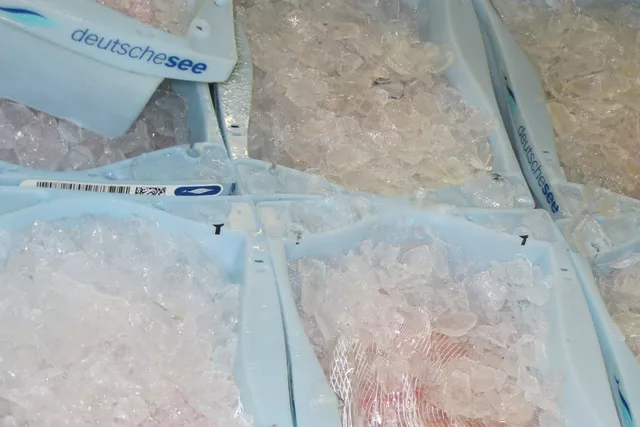
To cool meat or fish?
You want to chill meat or fish close to freezing point?
This should be done as quickly as possible and at irregular intervals?
Processes and ice qualities should be questioned.
Subjective assessments, as in the case of crushed ice quality or use, should be objectively discussed and proven. An approach that is not even put up for discussion because it is only perceived to a limited extent in the market, or not at all, should be factually verified. Then ice is required that is not sub-cooled and is easily transportable. In this case, our industrial ice maker is recommended, which always provides sufficient cooling capacity through ice, even at extreme load peaks.
Perceived advantages of chilling meat mass:
Due to its large surface area, our ice has an ideal structure when chopping in the mincer and mixer. The cooling effect is excellent. As the Buco ice is not too hard, the cutter knives do not become blunt so quickly.
Perceived benefits of fish cooling:
Test series conducted by companies in the salmon processing industry provide information on its use in daily use. For this purpose, a constant quantity of 20 kg of grade A salmon fillets was tested in different stages of cooling. 10 different test series were carried out with salmon in fish boxes. These fish boxes contained 3 kg Buco ice, 5 kg Buco ice and 7 kg Buco ice. These fish boxes were kept in a cold room at a constant temperature of 0°C for 120 hours. Thermometers were positioned inside the salmon so that the internal temperature of the fish could be measured continuously over this period. (Some fluctuations in the measured temperatures are due to the highly sensitive measuring device). Finally, it was found that the temperature of the salmon was constant at 0.5°C internal temperature, as shown by the tests on the three series of measurements of 3, 5 and 7 kg Buco ice in the fish boxes. The temperature diagrams showed that the internal temperature of the salmon was reduced from an initial temperature of 3.5°C to 5°C to a final temperature of 0.3°C to 0.5°C over a period of 10 - 12 hours, confirming homogeneous cooling.
Background and explanations on ice qualities and production costs:
Our chip ice of the BUCO ice machine is therefore optimal in the ratio of heat transfer and economy. Due to the temperature close to 0°C, there are further advantages of our chip ice, such as round and no sharp edges and no sub-cooling ( -8°C and thus freezer burn), as well as less clumping during transport or storage. The Buco chip ice machines are also variable in dimensions. Even though there are standardised dimensions, adaptation to installation in or above containers is just as feasible as other restrictions on the length, width or height of the Buco chip ice machine. We will be happy to share our experience with you in order to adapt this to your ideas.
In the comparison of flake ice (1mm thick and temperature -8°C to -10°C) and our crushed ice (chip ice 6mm to 8mm thick and temperature -0.5°C to -1°C), there are often subjective-visual preferences on the part of users with regard to the selection of an industrial ice maker for purchase. Customers usually prefer flake ice from a flake ice maker because it visually looks colder (whiter) and is therefore considered to be better and more effective ice. This is not the case. Ice develops its greatest heat transfer effect when it melts (0°C) and thus at 335 KJ/kg (80 kcal/kg). In addition, ice near 0°C is the most economical to produce, with the lowest energy costs. To put it in a nutshell, the production of our crushed ice from the ice machine takes place at half the operating costs compared to all drum systems. In addition, energy can also be saved in the storage of our ice, as our ice from the ice machine with a temperature of -0.5°C can be stored in silos of -1°C in a more energy-saving way at -1°C to -2°C at far lower costs than compared to the storage of flake ice at -10°C.

